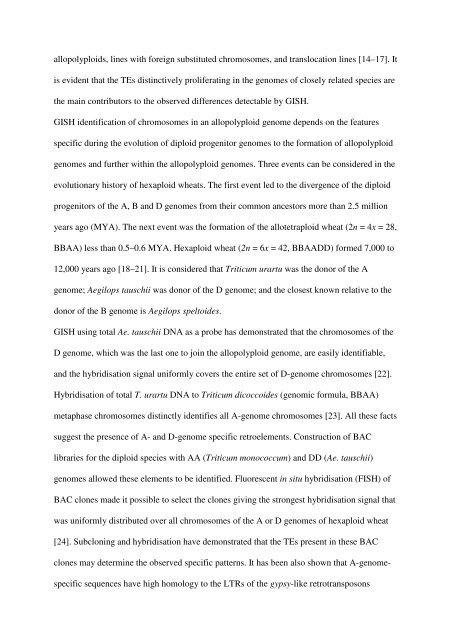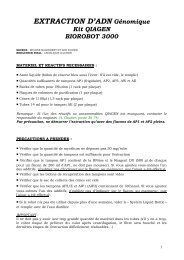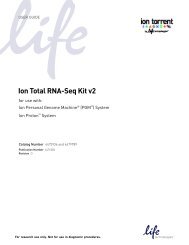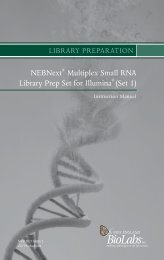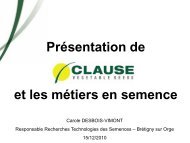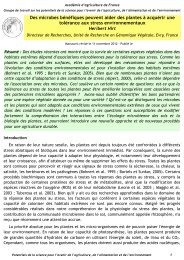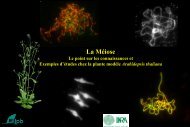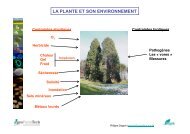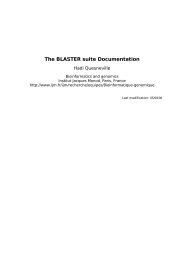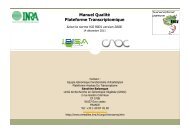The impact of Ty3-gypsy group LTR retrotransposons ... - URGV - Inra
The impact of Ty3-gypsy group LTR retrotransposons ... - URGV - Inra
The impact of Ty3-gypsy group LTR retrotransposons ... - URGV - Inra
Create successful ePaper yourself
Turn your PDF publications into a flip-book with our unique Google optimized e-Paper software.
allopolyploids, lines with foreign substituted chromosomes, and translocation lines [14–17]. It<br />
is evident that the TEs distinctively proliferating in the genomes <strong>of</strong> closely related species are<br />
the main contributors to the observed differences detectable by GISH.<br />
GISH identification <strong>of</strong> chromosomes in an allopolyploid genome depends on the features<br />
specific during the evolution <strong>of</strong> diploid progenitor genomes to the formation <strong>of</strong> allopolyploid<br />
genomes and further within the allopolyploid genomes. Three events can be considered in the<br />
evolutionary history <strong>of</strong> hexaploid wheats. <strong>The</strong> first event led to the divergence <strong>of</strong> the diploid<br />
progenitors <strong>of</strong> the A, B and D genomes from their common ancestors more than 2.5 million<br />
years ago (MYA). <strong>The</strong> next event was the formation <strong>of</strong> the allotetraploid wheat (2n = 4x = 28,<br />
BBAA) less than 0.5–0.6 MYA. Hexaploid wheat (2n = 6x = 42, BBAADD) formed 7,000 to<br />
12,000 years ago [18–21]. It is considered that Triticum urartu was the donor <strong>of</strong> the A<br />
genome; Aegilops tauschii was donor <strong>of</strong> the D genome; and the closest known relative to the<br />
donor <strong>of</strong> the B genome is Aegilops speltoides.<br />
GISH using total Ae. tauschii DNA as a probe has demonstrated that the chromosomes <strong>of</strong> the<br />
D genome, which was the last one to join the allopolyploid genome, are easily identifiable,<br />
and the hybridisation signal uniformly covers the entire set <strong>of</strong> D-genome chromosomes [22].<br />
Hybridisation <strong>of</strong> total T. urartu DNA to Triticum dicoccoides (genomic formula, BBAA)<br />
metaphase chromosomes distinctly identifies all A-genome chromosomes [23]. All these facts<br />
suggest the presence <strong>of</strong> A- and D-genome specific retroelements. Construction <strong>of</strong> BAC<br />
libraries for the diploid species with AA (Triticum monococcum) and DD (Ae. tauschii)<br />
genomes allowed these elements to be identified. Fluorescent in situ hybridisation (FISH) <strong>of</strong><br />
BAC clones made it possible to select the clones giving the strongest hybridisation signal that<br />
was uniformly distributed over all chromosomes <strong>of</strong> the A or D genomes <strong>of</strong> hexaploid wheat<br />
[24]. Subcloning and hybridisation have demonstrated that the TEs present in these BAC<br />
clones may determine the observed specific patterns. It has been also shown that A-genomespecific<br />
sequences have high homology to the <strong>LTR</strong>s <strong>of</strong> the <strong>gypsy</strong>-like <strong>retrotransposons</strong>


